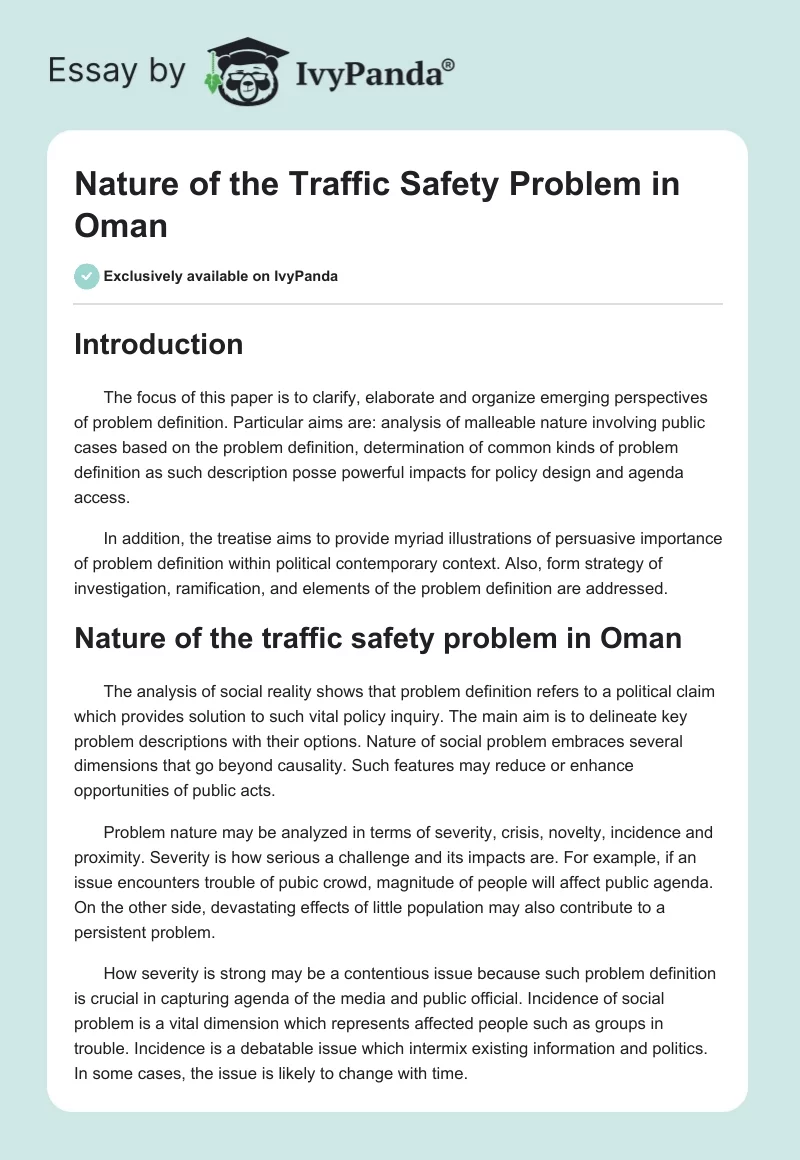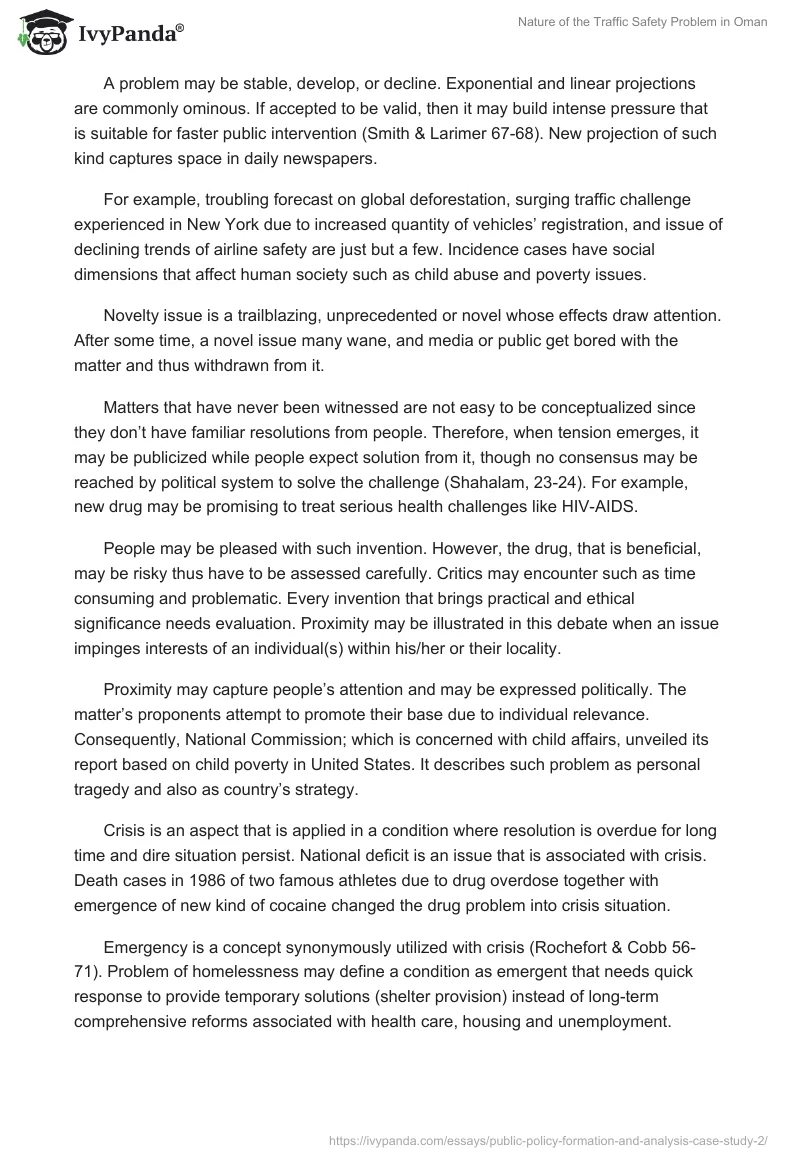Introduction
The focus of this paper is to clarify, elaborate and organize emerging perspectives of problem definition. Particular aims are: analysis of malleable nature involving public cases based on the problem definition, determination of common kinds of problem definition as such description posse powerful impacts for policy design and agenda access.
In addition, the treatise aims to provide myriad illustrations of persuasive importance of problem definition within political contemporary context. Also, form strategy of investigation, ramification, and elements of the problem definition are addressed.
Nature of the traffic safety problem in Oman
The analysis of social reality shows that problem definition refers to a political claim which provides solution to such vital policy inquiry. The main aim is to delineate key problem descriptions with their options. Nature of social problem embraces several dimensions that go beyond causality. Such features may reduce or enhance opportunities of public acts.
Problem nature may be analyzed in terms of severity, crisis, novelty, incidence and proximity. Severity is how serious a challenge and its impacts are. For example, if an issue encounters trouble of pubic crowd, magnitude of people will affect public agenda. On the other side, devastating effects of little population may also contribute to a persistent problem.
How severity is strong may be a contentious issue because such problem definition is crucial in capturing agenda of the media and public official. Incidence of social problem is a vital dimension which represents affected people such as groups in trouble. Incidence is a debatable issue which intermix existing information and politics. In some cases, the issue is likely to change with time.
A problem may be stable, develop, or decline. Exponential and linear projections are commonly ominous. If accepted to be valid, then it may build intense pressure that is suitable for faster public intervention (Smith & Larimer 67-68). New projection of such kind captures space in daily newspapers.
For example, troubling forecast on global deforestation, surging traffic challenge experienced in New York due to increased quantity of vehicles’ registration, and issue of declining trends of airline safety are just but a few. Incidence cases have social dimensions that affect human society such as child abuse and poverty issues.
Novelty issue is a trailblazing, unprecedented or novel whose effects draw attention. After some time, a novel issue many wane, and media or public get bored with the matter and thus withdrawn from it.
Matters that have never been witnessed are not easy to be conceptualized since they don’t have familiar resolutions from people. Therefore, when tension emerges, it may be publicized while people expect solution from it, though no consensus may be reached by political system to solve the challenge (Shahalam, 23-24). For example, new drug may be promising to treat serious health challenges like HIV-AIDS.
People may be pleased with such invention. However, the drug, that is beneficial, may be risky thus have to be assessed carefully. Critics may encounter such as time consuming and problematic. Every invention that brings practical and ethical significance needs evaluation. Proximity may be illustrated in this debate when an issue impinges interests of an individual(s) within his/her or their locality.
Proximity may capture people’s attention and may be expressed politically. The matter’s proponents attempt to promote their base due to individual relevance. Consequently, National Commission; which is concerned with child affairs, unveiled its report based on child poverty in United States. It describes such problem as personal tragedy and also as country’s strategy.
Crisis is an aspect that is applied in a condition where resolution is overdue for long time and dire situation persist. National deficit is an issue that is associated with crisis. Death cases in 1986 of two famous athletes due to drug overdose together with emergence of new kind of cocaine changed the drug problem into crisis situation.
Emergency is a concept synonymously utilized with crisis (Rochefort & Cobb 56-71). Problem of homelessness may define a condition as emergent that needs quick response to provide temporary solutions (shelter provision) instead of long-term comprehensive reforms associated with health care, housing and unemployment.
Cause of traffic safety problem in Oman
Problem causation defines the origin of the problem. Vital distinction is to determine whether a challenge is impersonal or individual cause. For example, underclass challenge may be attributed to either cultural and economical systems or lack of personal determination. In technological realm, (for example), equipment error or human duties may accounts for failure of Nuclear Plants.
Perception of causation is likely to be ingrained in human propensity. When something happens, immediate action is to examine underlying justifications as to why such event occurred. Accidental and intended causes are distinct to one another. Intended causes are human act purposively formed to bring specific impacts. According to public making policy, when an action is thought to be victorious, then it is rational.
But if it is not successful, such failure sources are linked to conspiracies. Some problems are simple and particular to a single cause. Others have various influences. Problem definitions based on two ways may predispose political action into various impacts. Channeling the aim into either two or one casual factor(s) is an indication that those who define the problem are willing to make immediate response.
More complex policies may be formed to promote prompt response. Policy makers may make foolish interventions when overwhelmed with inadequate knowledge of casual interaction. However, there exist vital exceptions to such common system. Policy makers may engender multi-pronged resolutions and multi-casual justifications among sophisticated attempts and those that posses great capability to create effective support.
Catastrophic of crude oil in Alaska is a good experience that counsels the society not to concentrate on personal scapegoats but rather to enhance mechanisms of cleanup and prevention of oil spill including other measurers such as faster spill response strategy and effective tanker design.
Characteristics of the problem population
Such problems are individuals and groups problems. This happens in social welfare whose aim intends to provide services and resources to particular target populations. Political interests to execute such determinations depend on the societal views of people who will benefit (Baumgartner and Jones, 2-11).
Balance between coercion and assistance based on policy designed depends on how negative or positive such perceptions are.These are vital dimensions for government‘s policy, because any attitudinal axes support to form aggregate impression If a community is unworthy or worthy to get support.
Out-group (out-law) individuals and deviants’ members may not get similar consideration to people who have shown public willingness and responsilibity. Threatening and sympathetic populations should be evaluated in the similar way. Such attributes may be used to account for mentally ill, elderly, poor and working persons.
Data of public opinion may also demonstrate favorable attitude of various claimants to be given support in such a society. Current public policy contracts this move.
It claims that it is not wise to use restrict resources in supporting disliked or silent people or sex offenders. In fact, States have to provide more for social aide to the AIDS and elderly and disadvantaged victims. Abusers should not be seen as unfortunate people in society. They should be supported without biasness.
Possible policy solutions
Definitional attempts in policy making develop from problem issues to those who are interested in and influenced by such to involve solution descriptions toward alleviating such challenges. Unless political harmony crystallizes such issues, government may not implement such. This policy emphasizes projective, empirical and scientific matters to assist in determining the impacts and likelihood to obtain desirable outcomems.
The most key focus at this level is to generate effective solutions. It is either worse or good impacts of political realm, a nostrum which have not been evaluated and applied in macro-social level. Thus, policy makers only engage in skepticism (guessing game) to choose either restraint or aggressive intervention.
This has influenced economic events with important strategies in experienced touted resolutions whose reliabilities are controversial.
For example, Nuclear Plants intends to provide reliable and cheap electricity, health programs is focused to enhance better living standards, training and employments aims to counteract dependency level, and recycling process attempts resolve disposal challenge. All these are faced with controversy due to skepticism.
Acceptable solution is not an effective action but has to be an act that conforms to an acceptable standard behavior. This is an ethical issue, though it is faced with controversy. For example, Chemical Warfare was brought by war experience in Middle East region. Such weapons were lethal not only to the targeted enemies but also to military arsenals who used them.
Owning lethal weaponry is not acceptable because it is harmful. Acceptability is an ethical issue that enhances new technology. Though, fetal tissue implantation is important in combating nervous problem in human life, it is opposed because such surgery may enhance abortion. It may be implanted in the person’s brain who suffers from Parkinson disease.
Policy intervention may be available, agreed and acceptable, but its affordability raises many inquiries. For instance, Policy makers are careful in carrying out financial tasks. People’s demands are increasing with new and existing programs. A funding has provided positive social and education impacts to disadvantaged preschool aged children (Anderson, 45).
There is controversy about how much should be funded to serve all children who are eligible. The country is also determined to improve infant mortality, though prenatal service is complex and expensive. It is controversial how all such services will be delivered, particularly through which way of funding.
Affordability invokes different standards of aims of participants. Finance comparison with various proposed policies, depending on cost estimates and budgetary constraints compared with social and economic costs of failure to act are prevalent.
Conclusively, problem definition remains a fundamental aspect in public making policy. It is a political process in enacting legislation, initiation and program design. This paper examines the impacts, origin and elements of problem definition linking this attempt to recent policy enacting progress and future investigation needs. Pubic making policy is based on logical natural consequence.
Social problems may be solved through gathering information. Public officials should assess the causes of the problem and to provide solution by effectively enacting new legislation. The strategy is carried out until the challenge is resolved. Empirical proof refutes such claim. This explains that other factors, a part from objective situations, are responsible to particular challenges.
Arbitrariness and controversy may affect how a situation is understood. There exist divergent views of significance, origin and effects of any challenge in the communal context. Language usage is critical in analyzing what aspect of any challenge to be evaluated.
Works Cited
Anderson, James. Public Policy Making, New York: Wadsworth / Cengage, 2011. Print.
Baumgartner, Frank R. and Bryan D. Jones. Agenda and Instabilities in American Politics. Chicago: University Chicago Press, 2009. Print.
Rochefort, David and Roger W. Cobb. ‘‘Problem Definition, Agenda Access and Policy Choice.’’ Policy Studies Journal 21.1(1993): 56-71. Print.
Shahalam, A, et. al. ‘‘Oman Traffic Safety Case: Traffic Accidents and Potential Causes.’’ National Engineering Conference on Roads 5(2001): 23-24. Print.
Smith, Kelvin B. and Christopher Larimer. The public policy theory primer. Bouldre: West View Press, 2009. Print.


